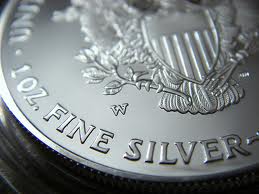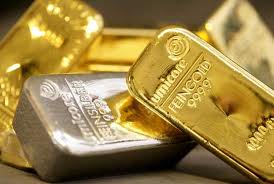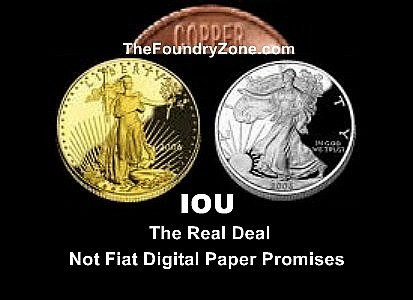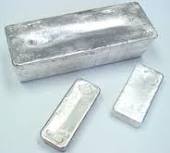Silver - (Ag)
Melting
Point:
1762
Fahrenheit
\ 961
Celsius
Boiling Point: 3924 Fahrenheit \ 2162 Celsius

Silver is a very soft metal and not commonly used in jewelry in pure form. Silver is a very ductile and malleable (slightly harder than gold) monovalent coinage metal with a brilliant white metallic luster that can take a high degree of polish. It has the highest electrical conductivity of all metals so it is extensively used in electronics and electrical contacts. Pure silver, aka Fine Silver (.999), so it is often mixed with an alloy like copper to make more durable items. However there are jewelry items made from pure silver and it is common in coinage and available in bullion bars too. It's markings are in percent of silver content. Its value as a precious metal was long considered second only to gold.
Among metals, pure silver has the highest thermal conductivity and one of the highest optical reflectivities. Silver also has the lowest contact resistance of any metal. Silver halides are photosensitive and are remarkable for their ability to record a latent image that can later be developed chemically. Silver is stable in pure air and water, but tarnishes when it is exposed to air or water containing ozone or hydrogen sulfide, the latter forming a black layer of silver sulfide which can be cleaned off with dilute hydrochloric acid.
Many well known uses of silver involve its precious metal properties, including currency, decorative items and mirrors. The contrast between the appearance of its bright white color to other media makes it very useful to the visual arts. It has also long been used to confer high monetary value as objects (such as silver coins and investment bars) or make objects symbolic of high social or political rank.
HEALTH EFFECTS:
Recorded use of silver to prevent infection dates to ancient Greece and Rome. Silver ions and silver compounds show a toxic effect on some bacteria, viruses, algae and fungi, typical for heavy metals like lead or mercury, but without the high toxicity to humans normally associated with these other metals. Its germicidal effects kill many microbial organisms in vitro, but testing and standardization of silver products is difficult. Silver is widely used in topical gels and impregnated into bandages because of its wide-spectrum antimicrobial activity. Silver itself is not toxic to humans, but most silver salts are, and some may be carcinogenic.[dubious – discuss] Silver and compounds containing it (such as colloidal silver) can be absorbed into the circulatory system and become deposited in various body tissues, leading to argyria, which results in a blue-grayish pigmentation of the skin, eyes, and mucous membranes. Although this condition does not otherwise harm a person's health, it is disfiguring and usually permanent
Other Uses:
Jewelery and silverware are traditionally made from sterling silver (standard silver), an alloy of 92.5% silver with 7.5% copper. In the US, only an alloy consisting of at least 92.5% fine silver can be marketed as "silver" (thus frequently stamped 925). Sterling silver is harder than pure silver, and has a lower melting point (893 C) than either pure silver or pure copper. Britannia silver is an alternative hallmark-quality standard containing 95.8% silver, often used to make silver tableware and wrought plate. With the addition of germanium, the patented modified alloy Argentium Sterling Silver is formed.
Silver is a constituent of almost all colored carat gold alloys and carat gold solders, giving the alloys paler color and greater hardness. White 9 carat gold contains 62.5% silver and 37.5% gold, while 22 carat gold contains up to 8.4% silver or 8.4% copper.
Pricing:
All metals as a commodity have dollar values based on several different factors. Many common industrial metals are priced by the ton or pound while other rarer or precious metals are priced by ounces or fractions of ounces. When pricing precious metals mixed with other common metals only the value of the precious metals are considered as the other metals by weight are valueless in comparison and actually add cost to buyers of mixed metals to refine or separate them out from the precious metals.
Silver is normally traded by Troy ounce, (ozt)
Silver on average is about 1/30th the price of gold. The ratio has varied from 1/15 to 1/100 in the past 100 years. According to the Silver Institute, silver's recent gains have greatly stemmed from a rise in investor interest and an increase in fabrication demand. In late April 2011, silver reached an all-time high of $49.76/ozt.
In earlier times, silver has commanded much higher prices. In the early 15th century, the price of silver is estimated to have surpassed $1200 per ounce, based on 2011 dollars. The discovery of massive silver deposits in the New World during the succeeding centuries has caused the price to diminish greatly and others believe also by market manipulation.
Metals and Currency and You!
The 20th century saw a gradual movement to fiat currency; backed by both controlled government and corporate sponsored media centers and the international "private" banking system to promote them. In a world where once all currency was backed up by one to one commodity based sovereign currencies, now all countries use declared value non-commodity reserve currencies. Example: The Federal Reserve Note is not Federal but Private Bank, Has NO Commodity Reserves to back up the paper/digital Note or IOU. Even the use of metal in coinage has changed from previously used pure base metals as copper or nickel to more lesser value substitutes of metal alloys which are under way to an completely planned digital global currency of replacement.
This is a controversial topic for Constitutionalist and many others who studied more closely the linking's of those with ulterior motives of control over our countries monetary system and the country itself. The United States Constitution declares, in Article I, Section 10, "No State shall... make any Thing but gold and silver Coin a Tender in Payment of Debts". Yet without a Constitutional Amendment and by just Act of Congress in the midnight hour they passed the Federal Reserve Private Banking System was passed. Hear Free audio Link on this. (opens in new window)

Also to this controversy, the move to fractionalized fiat (money just declared) causes lack of connection to accountability. When the government borrows currency through the printing press, and the creation of such new currency is backed by no real commodities, the creation of that currency is inflationary, and arguably counterfeit. Certainly such an action is similar to a person creating currency in his or her basement. Whether or not such an action can be correctly interpreted as counterfeiting, there can be no doubt that inflating the currency is criminal. Many feel this is also the cause for a condition where the country's debt has now out paced in fiat currency available to pay it. Many believe there is a reality of current currency collapse in the USA and Globally.
When one to one commodities are traded against their same or difference in values a certainty of confidence is also traded. The fiat currency proponents claim it is all a confidence game any way which is true until the confidence is gone by just declaring fair value exchange with no reasonable relationship to it. An example being when the uncoupling occurs of any tangible REAL commodity to vast differences against worthless paper or digital money to the reality of actual supply as in more debt than physical assets to pay off the debt. This can be seen in recent history by many countries in default or on the precipice of default like with the USA with the country's mega trillion deficit against Gross National Product, or a 700 plus trillion dollar unregulated derivatives (form of commodity insurance) market greater than physical commodities or currency on record to offset it. This can cause a melt down in fiat claims of value giving way to hyper inflation to balance and or collapse back down to commodity realities. Example: Pre-USA during the Revolutionary War it was said that because of inflated borrowed promissory money, it took a wagon load of money to buy a wagon load of supplies.
Here are some examples of recent fiat currencies in dollar inflations and collapse.
One dollar bill inflated to...
Zimbabwe – 100 trillion dollars, 2006
Venezuela – 10,000 bolívares, 2002
Romania – 50,000 lei, 2001
Turkey – 5 million lira, 1997
Belarus – 100,000 rubles, 1996
Ukraine – 10,000 karbovantsiv, 1995
Angola – 500,000 kwanzas reajustados, 1995
Georgia – 1 million laris, 1994
Yugoslavia – 10 billion dinar, 1993
Brazil – 500 cruzeiros reais, 1993
Russia – 10,000 rubles, 1992
Zaire – 5 million zaires, 1992
Nicaragua – 10 million córdobas, 1990
Peru – 100,000 intis, 1989
Bolivia – 5 million pesos bolivianos, 1985
Argentina – 10,000 pesos argentinos, 1985
Bolivia – 5 million pesos bolivianos, 1985
Chile – 10,000 pesos, 1975
One such famous default was the Mexican Peso in 1994 called, The 1994 Economic Crisis in Mexico, widely known as the Mexican peso crisis or the Tequila crisis, was caused by the sudden devaluation of the Mexican peso in December 1994. As each currency implodes and a shift of resources rush in to fill the vacuum it dilutes even further the remaining commodity / currency valuations. Now many countries globally have faltering currencies and high defecates threatening the global economic structure in a much fear realistic domino effect. When fiat currencies collapse all resorts back down to realistic trade / barter of all commodities be it food or supplies and raw materials including metals. Those with commodities in had can then easily exchange into the next currency structure an the new given rate if desired whereas those who held the previous fiat currency have nothing to show for it.

Silver like Gold, even Copper, Brass, Bronze or other real commodity metals in any quantities are good to obtain, own, and have on hand to hedge and trade against inflation or worse, currency collapse.
Boiling Point: 3924 Fahrenheit \ 2162 Celsius

Silver is a very soft metal and not commonly used in jewelry in pure form. Silver is a very ductile and malleable (slightly harder than gold) monovalent coinage metal with a brilliant white metallic luster that can take a high degree of polish. It has the highest electrical conductivity of all metals so it is extensively used in electronics and electrical contacts. Pure silver, aka Fine Silver (.999), so it is often mixed with an alloy like copper to make more durable items. However there are jewelry items made from pure silver and it is common in coinage and available in bullion bars too. It's markings are in percent of silver content. Its value as a precious metal was long considered second only to gold.
Among metals, pure silver has the highest thermal conductivity and one of the highest optical reflectivities. Silver also has the lowest contact resistance of any metal. Silver halides are photosensitive and are remarkable for their ability to record a latent image that can later be developed chemically. Silver is stable in pure air and water, but tarnishes when it is exposed to air or water containing ozone or hydrogen sulfide, the latter forming a black layer of silver sulfide which can be cleaned off with dilute hydrochloric acid.
Many well known uses of silver involve its precious metal properties, including currency, decorative items and mirrors. The contrast between the appearance of its bright white color to other media makes it very useful to the visual arts. It has also long been used to confer high monetary value as objects (such as silver coins and investment bars) or make objects symbolic of high social or political rank.
HEALTH EFFECTS:
Recorded use of silver to prevent infection dates to ancient Greece and Rome. Silver ions and silver compounds show a toxic effect on some bacteria, viruses, algae and fungi, typical for heavy metals like lead or mercury, but without the high toxicity to humans normally associated with these other metals. Its germicidal effects kill many microbial organisms in vitro, but testing and standardization of silver products is difficult. Silver is widely used in topical gels and impregnated into bandages because of its wide-spectrum antimicrobial activity. Silver itself is not toxic to humans, but most silver salts are, and some may be carcinogenic.[dubious – discuss] Silver and compounds containing it (such as colloidal silver) can be absorbed into the circulatory system and become deposited in various body tissues, leading to argyria, which results in a blue-grayish pigmentation of the skin, eyes, and mucous membranes. Although this condition does not otherwise harm a person's health, it is disfiguring and usually permanent
Other Uses:
Jewelery and silverware are traditionally made from sterling silver (standard silver), an alloy of 92.5% silver with 7.5% copper. In the US, only an alloy consisting of at least 92.5% fine silver can be marketed as "silver" (thus frequently stamped 925). Sterling silver is harder than pure silver, and has a lower melting point (893 C) than either pure silver or pure copper. Britannia silver is an alternative hallmark-quality standard containing 95.8% silver, often used to make silver tableware and wrought plate. With the addition of germanium, the patented modified alloy Argentium Sterling Silver is formed.
Silver is a constituent of almost all colored carat gold alloys and carat gold solders, giving the alloys paler color and greater hardness. White 9 carat gold contains 62.5% silver and 37.5% gold, while 22 carat gold contains up to 8.4% silver or 8.4% copper.
Pricing:
All metals as a commodity have dollar values based on several different factors. Many common industrial metals are priced by the ton or pound while other rarer or precious metals are priced by ounces or fractions of ounces. When pricing precious metals mixed with other common metals only the value of the precious metals are considered as the other metals by weight are valueless in comparison and actually add cost to buyers of mixed metals to refine or separate them out from the precious metals.
Silver is normally traded by Troy ounce, (ozt)
| 1 grain (gr) | = 64.79891 milligrams |
| 1 gram (g) | = 0.643 dwt = 15.432 gr = 0.0032 oz t = 0.035 oz av |
| 1 pennyweight (dwt) | = 1.555 g = 24 gr = 0.05 oz t = 0.055 oz av |
| 1 troy ounce (oz t) | = 31.103 g = 20 dwt = 480 gr = 1.097 oz av |
| 1 ounce avoirdupois (oz av) | = 28.3495 g = 18.229 dwt = 0.911 oz t |
| 1 troy ounce (oz t) 24K gold | Divisible into 24 ounce carats of 20 grains troy pure each |
Silver on average is about 1/30th the price of gold. The ratio has varied from 1/15 to 1/100 in the past 100 years. According to the Silver Institute, silver's recent gains have greatly stemmed from a rise in investor interest and an increase in fabrication demand. In late April 2011, silver reached an all-time high of $49.76/ozt.
In earlier times, silver has commanded much higher prices. In the early 15th century, the price of silver is estimated to have surpassed $1200 per ounce, based on 2011 dollars. The discovery of massive silver deposits in the New World during the succeeding centuries has caused the price to diminish greatly and others believe also by market manipulation.
Metals and Currency and You!
The 20th century saw a gradual movement to fiat currency; backed by both controlled government and corporate sponsored media centers and the international "private" banking system to promote them. In a world where once all currency was backed up by one to one commodity based sovereign currencies, now all countries use declared value non-commodity reserve currencies. Example: The Federal Reserve Note is not Federal but Private Bank, Has NO Commodity Reserves to back up the paper/digital Note or IOU. Even the use of metal in coinage has changed from previously used pure base metals as copper or nickel to more lesser value substitutes of metal alloys which are under way to an completely planned digital global currency of replacement.
This is a controversial topic for Constitutionalist and many others who studied more closely the linking's of those with ulterior motives of control over our countries monetary system and the country itself. The United States Constitution declares, in Article I, Section 10, "No State shall... make any Thing but gold and silver Coin a Tender in Payment of Debts". Yet without a Constitutional Amendment and by just Act of Congress in the midnight hour they passed the Federal Reserve Private Banking System was passed. Hear Free audio Link on this. (opens in new window)

Also to this controversy, the move to fractionalized fiat (money just declared) causes lack of connection to accountability. When the government borrows currency through the printing press, and the creation of such new currency is backed by no real commodities, the creation of that currency is inflationary, and arguably counterfeit. Certainly such an action is similar to a person creating currency in his or her basement. Whether or not such an action can be correctly interpreted as counterfeiting, there can be no doubt that inflating the currency is criminal. Many feel this is also the cause for a condition where the country's debt has now out paced in fiat currency available to pay it. Many believe there is a reality of current currency collapse in the USA and Globally.
When one to one commodities are traded against their same or difference in values a certainty of confidence is also traded. The fiat currency proponents claim it is all a confidence game any way which is true until the confidence is gone by just declaring fair value exchange with no reasonable relationship to it. An example being when the uncoupling occurs of any tangible REAL commodity to vast differences against worthless paper or digital money to the reality of actual supply as in more debt than physical assets to pay off the debt. This can be seen in recent history by many countries in default or on the precipice of default like with the USA with the country's mega trillion deficit against Gross National Product, or a 700 plus trillion dollar unregulated derivatives (form of commodity insurance) market greater than physical commodities or currency on record to offset it. This can cause a melt down in fiat claims of value giving way to hyper inflation to balance and or collapse back down to commodity realities. Example: Pre-USA during the Revolutionary War it was said that because of inflated borrowed promissory money, it took a wagon load of money to buy a wagon load of supplies.
Here are some examples of recent fiat currencies in dollar inflations and collapse.
One dollar bill inflated to...

Zimbabwe – 100 trillion dollars, 2006
Venezuela – 10,000 bolívares, 2002
Romania – 50,000 lei, 2001
Turkey – 5 million lira, 1997
Belarus – 100,000 rubles, 1996
Ukraine – 10,000 karbovantsiv, 1995
Angola – 500,000 kwanzas reajustados, 1995
Georgia – 1 million laris, 1994
Yugoslavia – 10 billion dinar, 1993
Brazil – 500 cruzeiros reais, 1993
Russia – 10,000 rubles, 1992
Zaire – 5 million zaires, 1992
Nicaragua – 10 million córdobas, 1990
Peru – 100,000 intis, 1989
Bolivia – 5 million pesos bolivianos, 1985
Argentina – 10,000 pesos argentinos, 1985
Bolivia – 5 million pesos bolivianos, 1985
Chile – 10,000 pesos, 1975
One such famous default was the Mexican Peso in 1994 called, The 1994 Economic Crisis in Mexico, widely known as the Mexican peso crisis or the Tequila crisis, was caused by the sudden devaluation of the Mexican peso in December 1994. As each currency implodes and a shift of resources rush in to fill the vacuum it dilutes even further the remaining commodity / currency valuations. Now many countries globally have faltering currencies and high defecates threatening the global economic structure in a much fear realistic domino effect. When fiat currencies collapse all resorts back down to realistic trade / barter of all commodities be it food or supplies and raw materials including metals. Those with commodities in had can then easily exchange into the next currency structure an the new given rate if desired whereas those who held the previous fiat currency have nothing to show for it.
For more
information
on this by
non-corporate
and
non-mass
media
government
controlled
information
see the
following
open
information
link.
Click >
FREEDOM
OF INFORMATION CENTER (opens in new window)

Silver like Gold, even Copper, Brass, Bronze or other real commodity metals in any quantities are good to obtain, own, and have on hand to hedge and trade against inflation or worse, currency collapse.